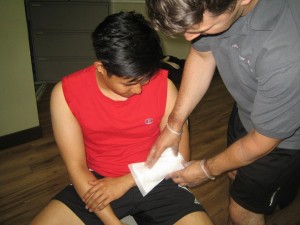Both animal and human bites can cause cuts, puncture wounds, crushing injuries and scrapes. Most can cause minor injuries that can be easily treated at home. If you will enroll in a first aid course, you will learn how to handle these wounds properly.
What you need to know about animal and human bites
Dealing with animal bites
Most cases of animal bites typically occur among school-age children. The hands, arms, face and legs are common sites for animal bites. Since most bite cases occur among children, you have to instruct children to be careful around animals since they can bite, especially those in the wild. Always remember that young children must be closely supervised when they are around animals.
Types of animal bites
Dog bites are the most common bites and usually occur during the summer season. Injuries can occur either by bothering the dog while asleep or eating or simply by teasing. Children are prone to dog bites especially on the arms, neck and head.
Cat bites can cause deep puncture wounds and has a high risk for bacterial infection. This is due to the deep wound that is difficult to properly clean.
Wild animal bites can occur while camping, hunting or hiking out in the wilderness. The risks include tetanus, rabies and infection from these bites.
Exotic pet bites such as from gerbils and mice can transmit certain diseases but rabies is not the concern. Bites from iguanas can put an individual at risk for infection but there are no other serious risks.
Livestock such as cows, horses and sheep possess powerful jaws that can deliver crushing bite injuries. The possible risks include rabies, tetanus and infection.
The basics on human bites
Human bites that causes a wound to the hand is considered serious. If an individual with a clenched fist strikes another individual in the mouth, the teeth can puncture or cut the skin over the knuckles. This is known as a fight bite in which the underlying tissues can get damaged and infection can likely develop in no time.

In some instances, children can bite other children and even adults. Take note that bites from children are not usually deep and not as strong as the adult bites. The bites are not likely to become infected and could not cause any damage to the underlying tissues.
Treatment for bites
If an individual sustains either an animal or human bite, there are certain steps to perform.
- Initially, you have to stop the bleeding by applying direct pressure over the wound.
- You have to determine whether other tissues such as the nerves, blood vessels, ligaments, tendons, joints, bones or internal organs have been damaged.
- Check if evaluation by a doctor is required.
- Clean the wound in order to prevent infections from occurring such as tetanus as well as viral infections such as cytomegalovirus and herpes simplex virus.
- Determine the risk for rabies and the need for proper treatment in order to prevent the disease.
- Check whether a tetanus shot is needed.
